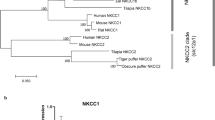Abstract
In the Antarctic Ocean salt concentration differs from the bottom to the surface owing to the seasonal forming and melting of sea ice. Antarctic teleosts present different lifestyle from benthic to pelagic. While benthic animals face a constant seawater salinity, benthic–pelagic animals have to face different salt concentration. Branchial morphology and ion–water transport proteins were compared in animals with different lifestyle. The ultrastructure of the gills was investigated by scanning electron microscopy (SEM). Na+/K+/ATPase, Na+/K+/Cl− cotransport protein NKCC1 and Aquaporin 3 (AQP3), were investigated by immunohistochemistry. The immunoreactivity for the ion transporter proteins were more intense in the active benthic–pelagic animals and in the icefishes than in the sluggish benthic ones. Conversely, AQP immunoreactivity was stronger in the animals with sedentary lifestyles. The SEM showed the secondary lamellae in the benthic–pelagic animals more densely packed with the exception of the haemoglobin free teleosts.







Similar content being viewed by others
References
Bystryansky JS, Richards JG, Schulte PM, Ballantyne JS (2006) Reciprocal expression of gill Na+/K+ATPase α-subunit isoforms α1a and α1b during seawater acclimation of three salmonid fishes that vary in their salinity tolerance. J Exper Biol 209:1848–1858
Coons AH, Leduc EH, Connolly JM (1955) Studies on antibody. I. A method for the histochemical demonstration of specific antibody and its application to a study of the hyperimmune rabbit. J Exper Med 102:49–59
Cutler CP, Cramb G (2001) Molecular physiology of osmoregulation in eels and other teleosts: the role of transporter isoforms and gene duplications. Comp Biochem Physiol 130A:551–564
De Vries AL (1971) Glycoproteins as biological antifreeze agents in Antarctic fishes. Science 172:1152–1155
DeVries AL (1990) The role of antifreeze proteins in freezing avoidance of Antarctic fishes. In Biology of Antarctic fishes. II Int. Meeting, Rovello, Italy
De Vries AL, Komatsu SK, Feeney RE (1970) Chemical and physical properties of freezing point depressing glycoproteins from Antarctic fishes. J Biol Chem 245:2901–2908
Dobbs GH, De Vries AL (1975) Renal function in Antarctic teleost fishes: serum and urine composition. Mar Biol 29:59–70
Evans DH, Piermarini PM, Choe KP (2005) The multifunctional fish gill: dominant site of gas exchange, osmoregulation, acid-base regulation, and excretion of nitrogenous waste. Physiol Rev 85:97–177
Forrest JM, Cohen AD, Schon DA, Epstein FH (1973) Na transport and Na-K-ATPase in gills during adapatation to sea-water: effects of cortisol. Am J Physiol 224:709–713
Gon O, Heemstra (eds) (1990) Fishes of the Southern Ocean. JLB Smith Institute of Ichthyology, Grahamstown
Gray IE (1954) Comparative study of the gill area of marine fishes. Bio Bull 107:219–225
Guynn SR, Schofield MA, Petzel DH (2002) Identification of mRNA and protein expression of the Na/K-ATPase α1-, α2-, and α3-subunity isoforms in Antarctic and New Zealand nototheiid fishes. J Exp Mar Biol Ecol 273:15–32
Henderson IW, Chan DKO, Sandor T, Chester Jones I (1970) The adrenal cortex and osmoregulation in teleosts. Memoirs Soc Endocrinol 18:31–55
Hughes GM, Morgan M (1973) The structure of fish gills in relation to their respiratory function. Biol Rev 48:419–475
Keys A (1931) Chloride and water secretion and absorption by the gills of the eel. Z Vergl Physiol 15:364–389
Kirkeby S, Thomsen EC (2005) Quantitative immunohistochemistry of fluorescence labelled probes using low-cost software. J Immunological Methods 301:102–113
Kunzmann A (1990) Gill morphometric of two Antarctic fish species Pleuragramma antarcticum and Notothenia gibberifrons. Polar Biol 11:9–18
Lignot JH, Cutler CP, Hazon N, Cramb G (2002) Immunolocalisation of aquaporin 3 in the gill and the gastrointestinal tract of the European eel Anguilla anguilla (L.). J Exper Biol 205:2653–2663
Masini MA, Sturla P, Prato P, Uva B (2000) Mitochondria-rich cells in Antarctic fish gills. Polar Biol 23:250–256
Nielsen S, Frokiaer J, Marples D, Kwon TH, Knepper MA (2002) Aquaporins in the kidney from molecules to medicine. Physiol Rev 82:205–244
O’Grady SM, De Vries AL (1982) Osmotic and ionic regulation in polar fishes. J Exper Mar Biol Ecol 57:219–228
Tipsmark CK, Madsen SS, Seidelin M, Christensen AS, Cutler CP, Cramb G (2002) Dynamics of Na+K+2Cl− cotransporter and Na+K+ATPase expression in the branchial epithelium of brown trout (Salmo trutta) and Atlantic salmon (Salmo salar). J Exp Zool 293:106–118
Uva BM, Masini MA, Devecchi M, Napoli L (1991) Renin-angiotensin system in Antarctic fishes. Comp Biochem Physiol 100A:897–900
Virkki LV, Cooper GJ, Boron WF (2001) Coning and functional expression of an MIP (AQP) homolog form killifish (Fundulus heteroclitus) lens. Am J Physiol 281:R1994–R2003
Wendalar-Bonga SE, van der Meijs CJM (1989) Degeneration and death, by apoptosis and necrosis, of the pavement and chloride cells in the gills of the teleosts Oreochromis mossambicus. Cell Tissue Res 255:235–243
Wilson JM, Randall DJ, Donowitz M, Vogl AW, Aki IP (2000) Immunolocalization of ion-transport proteins to branchial epithelium mitochondria-rich cells in the mudskipper Pteriophthalmodon schlosseri. J Exp Biol 203:2297–2310
Acknowledgments
This study was supported by a grant from the Italian PNRA.
Author information
Authors and Affiliations
Corresponding author
Rights and permissions
About this article
Cite this article
Masini, M.A., Ricci, F., Prato, P. et al. Branchial morphology and ion–water transport proteins in Antarctic teleosts with different modes of life. Polar Biol 31, 31–37 (2007). https://doi.org/10.1007/s00300-007-0329-4
Received:
Revised:
Accepted:
Published:
Issue Date:
DOI: https://doi.org/10.1007/s00300-007-0329-4




